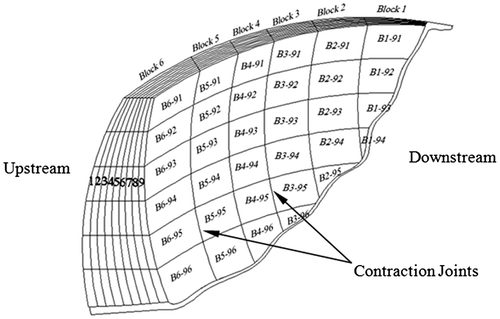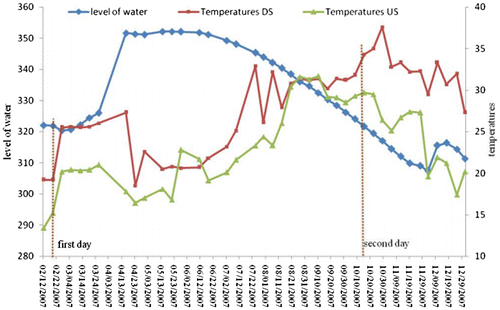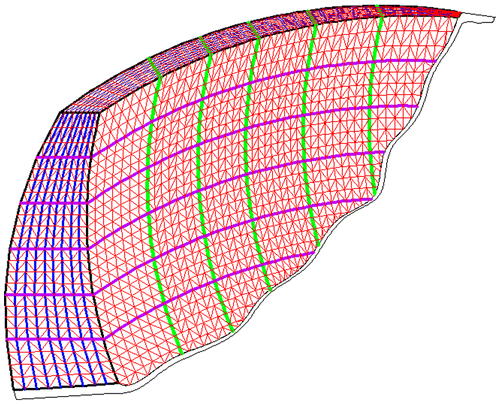 ?Mathematical formulae have been encoded as MathML and are displayed in this HTML version using MathJax in order to improve their display. Uncheck the box to turn MathJax off. This feature requires Javascript. Click on a formula to zoom.
?Mathematical formulae have been encoded as MathML and are displayed in this HTML version using MathJax in order to improve their display. Uncheck the box to turn MathJax off. This feature requires Javascript. Click on a formula to zoom.Absract
In this paper, an assumption used in the recent work of the author and his contributors considers the long-term concrete damage of the Dez arch dam as a homogeneous and isotropic process, was investigated in more detail and was adjusted. To this end, the vertical dam sections were divided into nine and six subsections along the thickness and height directions of the dam, respectively. In each subsection, a transversely isotropic damaged elastic constitutive law was considered for diagnostic analyses. Following the previous authors’ mentioned work, an optimization procedure (minimization of a certain error function) accompanied with an inverse thermal analysis was carried out. That analysis was performed within the framework of finite element (FE) method. Mentioned error function was defined as the sum of the squared residuals. Residuals were set as difference between nodal recorded displacements with inverse pendulums of the dam and the corresponding computed ones with the proposed model. Parameters considered as unknowns in the present inverse analysis, which have contributions in that above-mentioned error function, were the five independent elastic moduli presented in the formulation of the earlier mentioned transversely isotropic damaged elastic constitutive law: two Young’s moduli: one in the planes parallel to the up and down stream surfaces of the dam, called in-plane and the other in the perpendicular planes to those planes, named out-of-plane Young’s modulus; two Poisson’s ratios (in-plane and out-of-plane); and one shear modulus (out-of-plane). These parameters were identified performing numerous thermal inverse analyses. Obtained results revealed that the long-term damage of concrete of the Dez dam is a heterogeneous and anisotropic phenomenon because that the magnitude of the mentioned error function was obtained smaller than the corresponding value in the previous study which had been performed before based on the homogeneous and isotropic damage evolution assumption.
Introduction
Aggressive environment can contribute into the diminishing of the concrete mechanical properties directly or indirectly. Concrete is being deteriorated with time under the effects of ambient temperature and moisture fluctuations. A rise in temperature or moisture content of concrete can cause expansion; inversely, a drop in temperature or drying is generally associated with contraction or shrinkage in concrete, on the other hand. Under these repeatable circumstances, if concrete deformations are prevented or restrained, stresses build-up within this worldwide construction material. Consequently, these environmental-induced cyclic stresses can lead to the deterioration of concrete.
The Dez concrete arch dam is located in an aggressive condition from the environmental point of view based on the study of Naik [Citation1]. According to this study, the worst environmental condition of concrete is occurred when the weather is hot and contains high humidity. He described this situation quantitatively and specifically mentioned that at an air temperature of 122 °F and relative humidity of 100%, concrete becomes weak both in compression and tension. He added more that this is a critical condition for which the maximum load for a concrete structural member should be re-computed. Holding this issue in mind, it is interesting to note that the ambient temperature in the site location of the Dez dam reaches to 50 °C (122 °F) in the summer. Remembering this circumstance, on the other hand, the upstream face of the Dez dam at the same time is exposed dominantly to the reservoir water and therefore it is rational to suppose that some portions of the upstream face of the dam are completely saturated. So, it is no surprise if the environmental condition of the Dez dam in some days of the summer is classified as an aggressive condition.
Downie [Citation2] performed a comprehensive study on the effects of heat and moisture transport within the concrete on its mechanical properties. He concluded that higher temperature and degrees of saturation will yield lower concrete strength in compression, tension and corresponding modulus of elasticity. He added more that these two factors have negligible effect on Poisson’s ratio. Additionally, De Borst and Peeters [Citation3] found that the high temperature has a considerable effect on concrete creep strains. They declared that rising of temperature accelerates the creep of concrete considerably. Furthermore, the mechanism of force bearing in an arch dam is to transfer the hydrostatic pressure of the reservoir horizontally to the abutments and vertically to the foundation. At the Dez arch dam, because of the narrow shape of the canyon (V shape), the forces mainly are transferred in the horizontal direction with arch actions so the concrete of the Dez dam even near to the crest is under strong sustained compressive pressure.[Citation4, 5] This pressure near to the foundation is triaxial and near to the crest is biaxial because of the different thicknesses of these portions. So, the creep of the Dez concrete is inevitable and as a consequence the degradation of integrity and stiffness of the dam due to this creep is steadily becoming more progressive.[Citation6]
Besides to the above-mentioned direct physical environmental effects, the indirect chemical effects of the environment caused the concrete of the Dez dam to degrade progressively with time. High potential source of chemical degradation of the Dez dam is the calcium leaching. According to what reported by Dodds [Citation7], the Dez river water is completely saturated with CaCO3. So, based on findings of Cerny and Rovnanikova [Citation8] reported in their book, Transport Processes in Concrete, in the upstream face of the Dez dam, high hydrostatic pressures cause the water to diffuse into the inner parts of the concrete layers and dissolves the dissoluble hydration products, specifically in this case, i.e. the Ca(OH)2 of the cement paste.[Citation9] That dissolution is strongly possible because some amounts of the free carbon dioxide CO2.nH2O in the reservoir water of the Dez dam react with CaCO3 existed in that water to form carbonic acid H2CO3. This acid water diffuses into the concrete and dissolves the hydrated products and transports them to the reservoir water. This process leads to an increase in porosity of the concrete and consequently to decrease of the integrity and strength of the concrete.[Citation9]
Foregoing mentioned environmental factors along with the unexpected external mechanical loadings such as abutment movements or a sudden reduction in the reservoir water level or occasionally moderate earthquakes (all of them have occurred during the Dez dam life) are strengthening this hypothesis that the initial mechanical properties of the young dam can be deteriorated during a long period of time (dam is 42 years old).
Deterioration of concrete is both a physical and chemical phenomenon of the cement paste, the aggregate and the paste–aggregate interface. If degradation of concrete is progressing over time, the concrete structure may not be able to withstand the designed loads even if they have not changed.[Citation10] Even if there is no aggressive chemical in contact with the concrete of the dam,[Citation11] as it was mentioned, the saturation-dependent internal stresses acting on the nano- and microscales develop as a consequence of molecular adsorption and capillary condensation.[Citation12] Moisture movement in porous media of concrete of the dam may initiate cracks, and in turn, cracks strongly affect the permeability of the concrete.[Citation13] So, consequently, a concrete structure like the Dez arch dam which is in contact with the water of the reservoir for a long time and at the same time subjected to high gradient of temperature at the downstream face is likely to be damaged due to mentioned accumulated moisture-induced cracks.
On the other point of consideration, the concrete used in the Dez dam construction is completely different from the modern-day concretes and was built according to over than 45 years ago practice codes. So, even the ongoing comprehensive concrete material models such as the [Citation11, 12, 14–18], which are developed until today to evaluate the damaged material properties of old concrete structures, may not be able to predict the behaviour of the Dez dam under unexpected future loadings precisely.
Keeping in mind the foregoing issues, this paper in conjunction with the previous authors’ work on the same dam [Citation19] can be considered as a case study which aims at the completion of a global long-term deteriorated concrete material database model. This issue was conducted in these two companion studies through thermal inverse analyses of data records of instruments of the Dez dam without need for expensive damage diagnostic approaches.[Citation20, 21] Another advantage of this work is to verify that the predictive concrete material models currently are under development by the researchers.[Citation10] In this study, with respect to the previous authors’ work, an attempt has been made to provide new insights into the long-term concrete performance of the Dez dam. It is worth mentioning here that this research and its previous counterpart can be classified under a category labelled as (e) by Garbowski et al. [Citation21]. However, in the present research as a promotion to the previous one,[Citation19] the degradation of mass concrete of the dam was considered as a heterogeneous and anisotropic process. More descriptions about this heterogeneity and anisotropy have been discussed in the subsequent section.
Transversely isotropic elastic degradation of Dez dam’s concrete
In the previous study of the author on the Dez dam, it was demonstrated that the concrete of the dam was deteriorated elastically with time by employing an innovative inverse analysis method named as thermal inverse analysis. In that work, it was postulated that, this degradation was homogeneous and isotropic. Although, the results of the experimental tests conducted on dam confirmed this degradation strongly, they could not guarantee the homogeneity and isotropy of this deterioration with the same degree of certainty. Hence, in this research, the degradation of dam concrete was considered to be heterogeneous and anisotropic process, and it was decided to investigate the validity of this hypothesis. This hypothesis is strengthened with some following evidence:
From the heterogeneity point of view, it should be reminded that the environmental conditions at the upstream and downstream faces of the Dez dam are different. The upstream face of the dam is in contact with the reservoir water which is completely saturated, whereas, downstream of the dam is exposed to the ambient weather which is nearly dry. The wetness in Dez dam accelerates the degradation, whereas, dryness slows it down. The temperatures in these regions are also different. Temperature values at the upstream are moderate and at downstream are excessive. Excessive temperatures accentuate the deterioration and moderate temperatures play it down for concrete. So the moisture and temperature change significantly through the thickness of the dam at each altitude level. In addition, the variation of these two environmental parameters with respect to time is not the same for the upstream and downstream faces. Therefore, it is rational to assume that the concrete deterioration cannot be a homogeneous process along the dam thickness. Furthermore, the moisture and temperature are also changing along the height direction. Hydrostatic pressure varies linearly from the top to the bottom of the dam with the high magnitudes at the bottom. So, the moisture can penetrate and affect lower parts of the dam more effectively than the upper portions. On the other hand, because of the different sunshine expositions, the temperature would change along the height of the dam in both upstream and downstream faces. Hence, the concrete deterioration cannot be a homogeneous process along the dam height, similar to the discussed thickness direction.
Regarding the anisotropy, it should be noted here that the biaxial stress resultant at the in-planes of the Dez dam (planes parallel to the dam upstream/downstream surfaces) remains approximately constant due to the main forces acting on the dam e.g. hydrostatic pressures and gravity loads. Existence of higher compressive stresses in arches than those similar developed stresses in the cantilevers at the dam upper portions, and at the same time, the actions of higher compressive stresses in cantilevers than those build up corresponding stresses in arches at lower altitudes of the dam, may interpret well the above mentioned hypothesis. Besides to the above-mentioned natural boundary conditions, the essential boundary conditions of the Dez dam strengthen this idea that the nature of the damaged elastic tensor of the Dez concrete dam would be transversely isotropic. The elongation of the dam in arch and cantilever directions is nearly the same and is much greater than the dam elongation in the thickness direction. So, it is rational to expect that the degradation mechanism has different effects on in-planes and out-of-planes (planes regarded as being perpendicular to in-planes) of the dam (see Figure ).
It should be emphasised here that the author of this paper like to Fedele et al. [Citation22], believes that the degradation of concrete due to the environmental effects only could be merely considered as an isotropic damage process in overall behaviour of the dam. However, due to the past extreme loadings, from Fedele and his collaborators’ point of view, and, due to the permanent actions of the main ordinary loadings as well as the past extreme loadings from the opinion of the author of this article, this damage process can be transformed into an anisotropic process. Past extreme loadings such as earthquakes or unusual reservoir water reductions can produce diffused cracks within the concrete and on the other hand, the permanent main actions e.g. hydrostatic and gravity loads can provide a dominant state of stresses in the concrete, each of them makes the evolution of the long-term deterioration of the dam takes anisotropic features.
After extensive examination of the literatures, the author concluded that [Citation23] and [Citation21] are probably the only two diagnostic studies conducted on concrete dams considered the degradation of concrete as an anisotropic process. Oliveira and his collaborators performed a modal analysis on the Cabril arch dam located in Portugal using an inverse analysis method for dam material parameter identification. However, they have only modelled a small damaged zone (cracked zone) of the dam with an orthotropic transversely isotropic elastic constitutive law and considered the rest of the dam as isotropic material. Moreover, they have assumed that two of the fifth independent elastic modulus e.g. the elastic modulus and Poisson’s ratio of the plane of isotropy are known values and the rest three unknown material parameters were identified in their research. On the other hand, Garbowski et al. [Citation21] performed an inverse analysis on a roller compacted concrete dam using the so called DIC technique (Digital Image Correlation) for analysing the obtained images from a portion of the surface of the dam which experienced some displacements under the pressure imposed on it with a flat-jack through a T-shaped slots. They have identified the elastic and shear modulus of the concrete in the presence of orthotropy. They reported that the advantage of their method was that no data from extensometers were needed. Although Garbowski and his colleagues have performed a worthwhile attempt for diagnosing the material parameters of the dam, but the authors of this paper believe that their approach may suffer from two main drawbacks. Firstly, the accuracy of obtaining results is strongly dependent on the accuracy of the field operations and related mathematical theories. Secondly, the results are obtained from a local portion and under an artificial procedure (virtual loadings and virtual resulted displacements), so these results cannot be extended easily to the global mass concrete of the dam. Apart from these two mentioned deficiencies, they have considered the dam as a homogeneous medium and have taken the Poisson’s ratio components of transversely isotropic elastic tensors as known parameters. So, they have only identified the last three parameters like the work of Oliveira et al. [Citation23].
This issue motivated the author of this article to investigate in more detail the long-term degradation of concrete of the Dez dam in the presence of anisotropy using the innovative thermal inverse analysis.[Citation19] Considering Figure , the constitutive law for the long-term deterioration of Dez concrete can be stated as relation:(1)
(1)
In the above relation, EH denotes the Young’s modulus along the X-axis (axis of elastic symmetry) and EV indicates the corresponding elastic parameter in the plane of isotropy e.g. Y–Z plane herein. νHV is Poisson’s ratio, characterising the transverse strain reduction in plane of isotropy (Y–Z) due to tensile stress in a direction normal to it (X). νV represents also Poisson’s ratio but in the plane of isotropy. GH stands for the shear modulus for planes normal to plane of isotropy.
Thermal inverse solution using finite element method
The dam was sub-divided in this study into nine individually homogeneous zones in the thickness direction and into six similar sections along the height of the dam to take into account the heterogeneity of the long-term damage process of the Dez dam’s concrete in the analysis.
This subdivision was performed taking into account the Dez dam geometrical characterizations and construction practice stages as well as the optimization of the time consumes for each analysis to be completed. Figure shows a part of the dam with the scheme used for sub-dividing. The Word ‘Block’ in this figure marks the vertical cantilevers of the dam separated by the contraction joints. These contraction joints were contributed in the Finite Element (FE) model.
According to Equation (1), for each integration point of these sub-regions of the F.E. model, five independent constants of the compliance matrix C – the transversely isotropic elastic constitutive matrix – e.g. two Young’s moduli, two Poisson’s ratios and one shear modulus were attributed to take into account the anisotropy of the long-term concrete damage in the analysis. These unknowns were considered in a general form to be the variables of a specified error function which was trying to be minimised in the inverse analysis. In fact, an arrangement of the five above-mentioned unknowns was assigned in the sampling points for each subdivision of the dam at each try of the FE analysis. An arrangement which minimised that error function was selected as the solution of the inverse analysis. The detail of this thermal inverse solution has been described in the previous study of the author.[Citation19] The only difference between that previous solution and the current solution is that, in this new inverse analysis, the several sets of the unknown material parameters, i.e. the five components of the above-mentioned C matrix, are considered as the variables of the error function in each subdivision of the dam. However, in the previous study, only three material parameter values of the isotropic damaged elastic matrix for the whole of the dam, e.g. the Young’s modulus, Poisson’s ratio and thermal expansion coefficient were selected as the variables of the error function in the inverse analysis. So, the inverse analysis for these two studies is the same and only the variables of the error function are different. The definition of the error function in this new attempt is the same as the corresponding error function in the previous study.[Citation19] After performing each FE analysis, the magnitude of this error function was evaluated according to the following equation:(2)
(2)
In the above equation, J is the objective error function, is the set of the five mentioned above variables,
is the vector of the residuals and
denotes the identity matrix. Residual is defined as the difference between the nodal recorded displacements with inverse pendulums of the dam and the corresponding computed ones with the proposed model. This residual can be stated in the mathematical form as the following:
(3)
(3)
In relation (3), denotes the recorded displacements in each node with the inverse pendulums of the dam and
stands for the computed displacement vector by the proposed FE model. By performing each FE analysis, relative displacements of the nodal points of the dam were computed and recorded in the vector. This vector is a function of the mentioned unknown parameters
, e.g.
, based on the theory of the elasticity rewritten in the FE framework briefly here (Equations (4)–(7)) where
includes two Young’s moduli, two Poisson’s ratios and one shear modulus, according to Equation (1).
(4)
(4)
(5)
(5)
(6)
(6)
(7)
(7)
In relations (4)–(7), is the stiffness matrix,
denotes the corresponding nodal force vector contains the effects of the gravity, hydrostatic and thermal actions, B is the strain–displacement matrix, D indicates the transversely isotropic elastic fourth tensor which is identical to the inverse of the compliance matrix C mentioned earlier in the text (
) and Ω is the volume of each sub-divisions of the dam. Equation (7) states that the total stiffness and force vector are obtained through assembling procedure in FE method. For contributing the thermal effects into the FE inverse analysis, the same approach to the previous study was implemented.[Citation19] The temperature gradient for each nodal point in the FE model was obtained using the records of the thermometers located within the dam body. Based on these data records, the gradient was defined as the difference between the recorded temperatures of a node in two different days of a specific year, in this study 2007s, see Figure . These days were selected in such a way that provides a relatively noticeable temperature difference in the nodes with no significant difference in the reservoir water level of the dam.
For Dez dam, as an old dam, there are only three levels on which the inverse pendulums data are available. So, for the other nodal points in the FE mesh of the dam, the temperatures are derived using the proper interpolation and extrapolation. Hence, the error function defined earlier in the relation (2) is in fact obtained as below by the proposed model:(8)
(8)
In which,(9)
(9)
In relation (9), denotes for example the computed relative displacement at elevation 285 of the dam
refers to the recorded corresponding value with pendulums.
The details of the FE model were completely described in the previous accompanied paper.[Citation19] A schematic FE model of the dam is depicted in Figure and the true FE model is shown in Figure .
For dam and its support modelling, 27,241 and 4327 elements with 2503 and 3471 nodal points were used, respectively, leading to considering of 17,992 degrees of freedom for the problem in hand.
Results and discussion
After performing several sensitivity analyses on the material parameters, it was revealed that the objective error function J does not alter considerably through the variation of the thermal expansion coefficient, so this parameter was considered as a constant in the analyses and its magnitude was considered equal to the value which obtained before from a previous study by the authors, i.e. thermal expansion coefficient = 1/°C. However, it was also pointed out that the magnitude of error function J changes noticeably when the Poisson’s ratios change.
First stage of solution
Furthermore, during these sensitivity parameter analyses, it was revealed that the Young’s modulus has the greatest effect on the error function. Hence, for doing the analyses, at first, these two variables were set to be changed within a logic interval value, e.g. from 20 to 40 GPA and the other three remained variables were considered as constants and equal to their average obtained values in the previous study [Citation19] e.g. the Poisson’s ratios (νHV) and (νV) were considered as 0.2 and the shear modulus (GH) was considered variably and computed according to the relation . The final result of this first stage of the analyses has been outlined in Table . For the sake of brevity, only the final results are presented.
Table 1. Obtained Young’s modulus which minimise the error function J at the end of the first stage of analyses.
In the above table, the word ‘zone’ points to the subdivisions numbered in Figure , zone 1 denotes the upstream part of the dam, zone 5 indicates the central part of the dam and finally zone 9 marks the downstream part of the dam. J1, J2, J3 were defined in the previous section through relation (9).
As it can be seen from this table, the optimum values for the Young’s modulus (EH), the out-of-plane modulus along the x-axis direction (see Figure ), were obtained as 25, 32 and 26 GPA for the upstream, central and downstream parts of the dam, respectively. The corresponding values for the Young’s modulus (EV), the in-plane modulus acting in the plane of isotropy Y–Z, were obtained as 29, 32 and 31 GPA, respectively. Also, from this table, it can be derived that, for these obtained values of material parameters, the corresponding relative displacements at levels 331, 315 and 285 of the dam e.g. uc331 uc315 online uc285 in the upstream–downstream direction which were computed from the proposed F.E. model are 11.24, 8.08 and 2.655 mm, respectively. The other last three columns of Table show the magnitudes obtained for J1, J2, J3 defined by the relation (9). The last column, gives the value of the error function J.
Second stage of solution
At the second stage of the analyses, the above obtained values for EH and EV were kept constant and the values of the Poisson’s ratios (νHV) and (νV) were set to be changed in a rational interval from 0.1 to 0.3. In this stage, the values of GH were computed using the same relation used in the previous stage, i.e. , but with this difference that the values of EH were considered as constants and equal to the obtained results in the previous stage. The final obtained results of this stage of inverse analyses have been summarised in Table . As it can be seen from this table, the values for Poisson’s ratios (νHV) and (νV), the Poisson’s ratio in the out-of-plane of isotropy and the Poisson’s ratio in the plane of isotropy, were obtained as 0.19 and 0.15, respectively. Other obtained values can be interpreted as what done for Table . As it can be seen, the value of the error function J at the end of the second stage of the analyses that has been obtained is smaller than the corresponding value at the end of the first stage (5.884E-07 ˂ 9.184E-07). This shows that the trend of the calculation is desired and the analyses tend to converge to the final solution.
Table 2. Obtained Poisson’s ratios which minimise the error function J at the end of the second stage of analyses.
Third stage of solution
On the third and final stage of solution procedure, the foregoing obtained values were kept constant and only the out-of-plane shear modulus was set to be varied in a rational interval from 5 to 25 GPA during the calculations. The final obtained results of this stage have been brought in Table . It is observed from this table that for the upstream, central and downstream parts of the dam section, the values of 13, 14 and 13.5 GPA have been obtained for shear modulus GH respectively. The final value of the error function which was obtained at the end of this stage is obtained equal to 5.085E-07.
Table 3. Obtained shear modulus which minimise the error function J at the end of the Third stage of analyses.
It is worth mentioning that the above tables have been shown in an order that coincides with the order that inverse parameter identifications were performed in this attempt. Hence, the optimum or minimum of function J can be found in the last table (Table ). As it can be seen, for avoiding from the local optimization, and reach to a global solution, the interval value change for each of the above mentioned unknown parameters has been selected reasonably wide. Furthermore, as it was mentioned earlier, prior to start the solution procedure, several sensitive parameter analyses have been performed to design the proper solution algorithm.
The final value obtained for error function, i.e. 5.085E-07 is approximately 10 times smaller than the corresponding value obtained in the previous study done by the authors,[Citation19] e.g. 1.37 E-06 based on the assumption of homogeneity and isotropy. Therefore, it can be concluded that the long-term deterioration process of concrete of the Dez dam is a both heterogeneous and anisotropic process. Figures show the variations of the identified material parameters in a typical vertical section of the Dez dam.
Figure 6. Variation of the out-of-plane EH and in-plane EV elastic modulus (GPA) in a typical vertical section of the Dez dam.
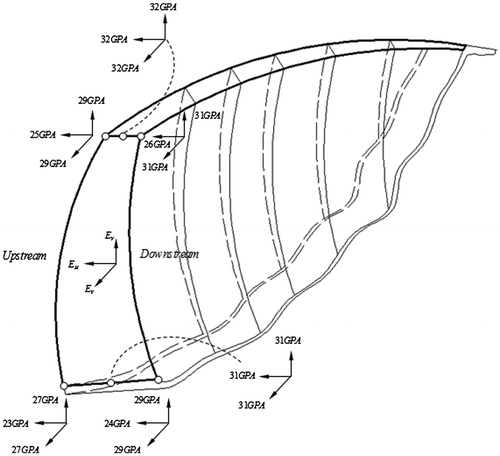
Figure 7. Variation of the out-of-plane νHV and in-plane νV Poisson’s ratios in a typical vertical section of the Dez dam.
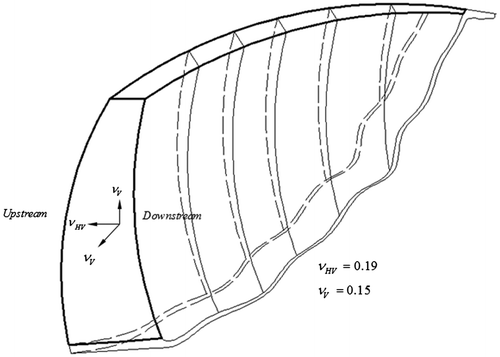
Figure 8. Variation of the out-of-plane GH and in-plane GV shear modulus (GPA) in a typical vertical section of the Dez dam.
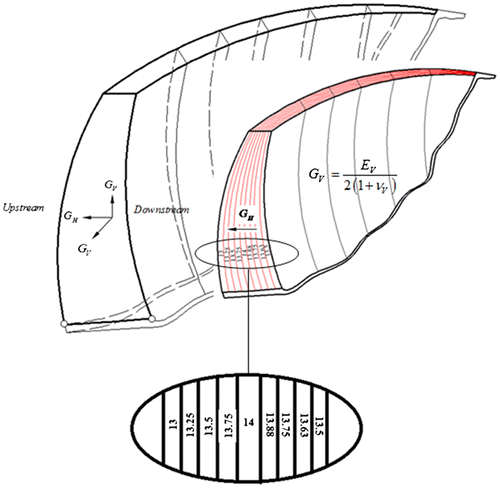
The central part of the dam has not altered by any degradation due to ageing. By moving from this central zone to the downstream and upstream faces of the dam, it was observed that the Young’s modulus decreased significantly. This reduction is more noticeable for the out-of-plane elastic modulus e.g. Young’s modulus along the upstream-downstream direction in comparison to the in-plane elastic modulus (plane of isotropy) of the dam. With respect to the Poisson’s ratio, it was concluded that the long-term damage of this parameter was not a heterogeneous process and was just an orthotropic damage. The out-of-plane Poisson’s ratio was obtained greater than the in-plane corresponding value. A similar observation was obtained for shear modulus. The out-of-plane shear modulus was obtained smaller than the in-plane corresponding value.
Conclusions
In this paper, subsequent to the previous attempt done by the authors on the Dezdam [Citation19] and based on those findings, a similar effective thermo-elastic inverse analysis has been implemented in order to investigate in more detail manner the damage process of the mass concrete of this dam after a long time from its operation time start.
By reviewing the obtained results, it was revealed that the ongoing deterioration of the concrete material of the Dez dam is a heterogeneous and orthotropic process. Heterogeneity is due to the difference in the environmental conditions circumvented the dam as well as the change of hydrostatic and gravity loads along the height of the dam and anisotropy because of the shape of the dam and the state of stresses resulted from the permanent external loading exposed on the dam.
Acknowledgements
Authors are so grateful to Yaqub Arab, the head and his assistants Ebrahim Barati Choobi and Kambiz Amiri in Dam Stability Control Center of Water&Power Authority of Khouzestan Province of Iran.
Disclosure statement
No potential conflict of interest was reported by the authors.
References
- Naik TR. Temperature effects on concrete. Philadelphia, PA: American society for testing and materials; 1985.10.1520/STP858-EB
- Downie B. Effect of moisture and temperature on the mechanical properties of concrete. [Thesis for master of science degree, department of mechanical and aerospace engineering]. Morgan town, WV; 2005.
- De Borst R, Peeters M. Analysis of concrete structures under thermal loading. Comput. Methods Appl. Mech. Eng. 1989;77:293–310.10.1016/0045-7825(89)90079-0
- Arch dam design. U.S. army corps of engineers. Washington (DC); 1994. p. 20314–21000.
- Engineering and Research Center, Office of Design and Construction. Design criteria for concrete arch and gravity dams. Washington (DC): United states department of the interior bureau of reclamation; 1977.
- Ruiz MF, Muttoni A, Gambarova PG. Relationship between nonlinear creep and cracking of concrete under uniaxial compression. J. Adv. Concr. Technol. 2007;5:1–11.
- Dodds RK. Measurment and analysis of rock physical properties on Dez Project, Iran. Testing Techniques for Rock Mechanics, ASTM STP 402, Am. Soc. Testing Mats., 1966. p. 52.
- Cerny R, Rovnanikova P. Transport processes in concrete. New York (NY): Spon Press; 2002.
- Ekstrӧm, T. Leaching of concrete, experiments and modeling. Report TVBM-3090. Sweden: Division of Building Materials at the Lund Institute of Technology; 2001.
- Dam Safety Technology Development Program. Material properties model of aging concrete. Report DSO-05-05. Denver (CO): U.S. Department of Interior. Bureau of Reclamation. Technical Service Center; 2005.
- Nguyen VH, Nedjar B, Torrenti JM. Chemo-mechanical coupling behaviour of leached concrete. Nucl. Eng. Des.. 2007;237:2090–2097.10.1016/j.nucengdes.2007.02.012
- Bangert F, Grasberger S, Kuhl D, et al. Environmentally induced deterioration of concrete: physical motivation and numerical modeling. Eng. Fract. Mech. 2003;70:891–910.10.1016/S0013-7944(02)00156-X
- Grasberger S, Meschke G. Thermo-hygro-mechanical degradation of concrete: from coupled 3d material modelling to durability-oriented multified structural analyses. Mater. Struct./Concr. Sci. Eng. 2004;37:244–256.
- Meschke G, Grasberger S. Numerical Modeling of Coupled Hygromechanical Degradation of Cementitious Materials. J. Eng. Mech. 2003;129:383–392.10.1061/(ASCE)0733-9399(2003)129:4(383)
- Meschke G, Leonhart D, Timothy J, et al. Computational mechanics of multiphase materials-modeling strategies at different scales. Comput. Assist. Mech. Eng. Sci. 2011;18:73–89.
- Gawin D, Pesavento F, Schrefler BA. Hygro-thermo-chemo-mechanical modelling of concrete at early ages and beyond. Part I: hydration and hygro-thermal phenomena. Int. J. Numer. Meth. Eng. 2006;67:299–331.10.1002/(ISSN)1097-0207
- Gawin D, Pesavento F, Grymin W, et al. Numerical modeling of concrete degradation due to alkali-silica reaction in variable hygro-thermal conditions. Computer Methods in Mechanics. Warsaw, Poland; 2011.
- Kuhl D, Bangert F, Meschke G. Coupled chemo-mechanical deterioration of cementitious materials. Part II. Numerical methods and simulations. Eng. Fract. Mech. 2003;70:891–910.
- Labibzadeh M, Khajehdezfuli A, Khayat M. Elastic strentgh diagnosis of the Dez concrete arch dam using thermal inverse analysis. J. Perform. Constr. Facil. (ASCE). 2014;24. doi:10.1061/(ASCE)CF.1943-5509.0000660.
- Fedele R, Maier G. Flat-jack tests and inverse analysis for the identification of stress states and elastic properties in concrete dams. Meccanica. 2007;42:387–402.10.1007/s11012-007-9061-y
- Fedele R, Maier G, Miller B. Identification of elastic stiffness and local stresses in concrete dams by in situ tests and neural networks. Struct. Infrastruct. Eng. 2005;1:165–180.
- Fedele R, Maier G, Miller B. Health assessment of concrete dams by overall inverse analyses and neural networks. Int. J. Fract. 2006;137:151–172. doi:10.1007/s10704-006-6582-7.
- Oliveira S, Toader AM, Vieira P. Finding the elastic coefficients of a damaged zone in a concrete dam using material optimization to fit measured modal parameters. 2nd International Conference on Engineering Optimization; 2010 September 6–9; Lisbon.


